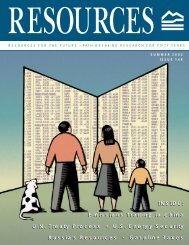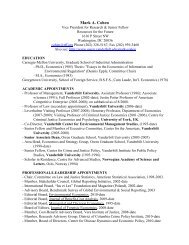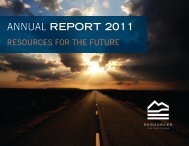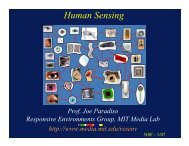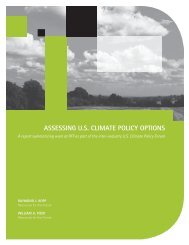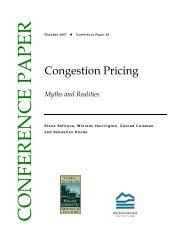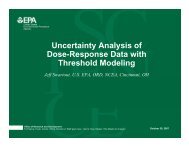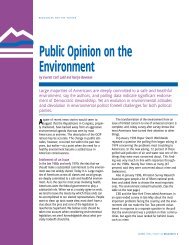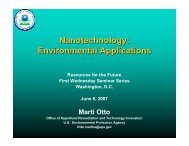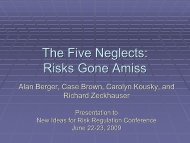Download Presentation (PDF) - Resources for the Future
Download Presentation (PDF) - Resources for the Future
Download Presentation (PDF) - Resources for the Future
Create successful ePaper yourself
Turn your PDF publications into a flip-book with our unique Google optimized e-Paper software.
Precautionary Regulation<br />
of Nanotechnologies<br />
Jennifer Sass, Ph.D.<br />
NRDC, Washington, DC<br />
Email: jsass@nrdc.org<br />
J. SASS NRDC 2007 1
Nanotechnologies may result in large-<br />
scale social disruption…<br />
“… comparable perhaps to <strong>the</strong> Industrial Revolution—but<br />
compressed into a few years. This has <strong>the</strong> potential to disrupt<br />
many aspects of society and politics…Weapons and<br />
surveillance devices could be made small, cheap, powerful,<br />
and very numerous... Overuse of inexpensive products could<br />
cause widespread environmental damage... There are<br />
numerous severe risks—including several different kinds of<br />
risk—that cannot all be prevented with <strong>the</strong> same approach.”<br />
-Center <strong>for</strong> Responsible Nanotechnology (2006)<br />
www.crnano.org/dangers.htm<br />
J. SASS NRDC 2007 2
Nanotechnologies and war<br />
“The potential <strong>for</strong> NT innovations in chemical and<br />
biological weapons is particularly disquieting, as<br />
NT can considerably enhance <strong>the</strong> delivery<br />
mechanisms of agents or toxic substances. The<br />
ability of nanoparticles to penetrate <strong>the</strong> human<br />
body and its cells could make biological and<br />
chemical warfare much more feasible, easier to<br />
manage and to direct against specific groups or<br />
individuals.”<br />
NATO Parliamentary Assembly Committee (2005)<br />
179 STCMT 05 E - THE SECURITY IMPLICATIONS OF<br />
NANOTECHNOLOGY<br />
www.nato-pa.int/Default.asp?SHORTCUT=677<br />
J. SASS NRDC 2007 3
Potential environmental, health, social<br />
& economic impacts<br />
• NTs are predicted to reshape <strong>the</strong> world from <strong>the</strong> atom up<br />
• This requires that we ask critical questions about purpose,<br />
predictability, ownership, risk and responsibility<br />
• Yet <strong>the</strong> primary debate about nanotechnology is primarily<br />
limited to toxicity risks, ignoring broader implications<br />
• Role <strong>for</strong> non-governmental organizations (NGO’s), social<br />
scientists, ethicists, and civil society in a global dialogue to<br />
shape <strong>the</strong> potential future of NTs<br />
J. SASS NRDC 2007 4
Problem: no regulatory oversight<br />
Must trigger a mass/vol threshold to trigger most<br />
regulation (TSCA, 10k kg/yr; OSHA, nuisance<br />
dust std 5 mg/cu.m)<br />
Burden on govt to prove harm; No data means no<br />
risk<br />
Reg’s target chemical, not final use/product<br />
No detection equipment means no en<strong>for</strong>cement<br />
ability<br />
J. SASS NRDC 2007 5
The Nano-Titanic has already left port<br />
More than $50 billion of nano-enabled products were<br />
sold worldwide in 2006;<br />
<strong>the</strong> US holds approximately 6,800 nanotechnologyrelated<br />
patents .<br />
Industry Week,<br />
May 2007<br />
J. SASS NRDC 2007 6
EXPOSURE POTENTIAL<br />
Inhaled nanomaterials have <strong>the</strong><br />
potential to pass directly to <strong>the</strong><br />
brain, and from<br />
<strong>the</strong> lungs into<br />
<strong>the</strong> blood stream.<br />
Nemmar et al, 2001, 2002. (Reviewed in Borm PJ, Kreyling W: J<br />
Nanosci Nanotechnol 2004, 4:521-531)<br />
J. SASS NRDC 2007 7
Nano metal oxides in sunscreens may<br />
penetrate skin, though most tests on intact<br />
skin have reported only limited penetration.<br />
Ingested nano<br />
materials<br />
pass from <strong>the</strong><br />
gut into <strong>the</strong><br />
blood stream.<br />
Borm et al. Particle and Fibre<br />
Toxicology 2006 3:11<br />
J. SASS NRDC 2007 8
TOXICITY/HAZARD POTENTIAL<br />
Instilled single walled carbon<br />
nanotubes induce progressive,<br />
irreversible lung damage and<br />
fibrosis in test rodents<br />
1 mg/kg SWCNT led to fibrosis after 1<br />
week<br />
Warheit et al, Toxicological Sci 77, 117-125 (2004).<br />
Reviewed in Oberdorster et al, Environ Health Perspect,<br />
113(7) (2005)<br />
J. SASS NRDC 2007 9
Nano-size air pollution is deadly<br />
Ultrafine air pollution is linked to<br />
increased lung cancer, heart, and lung<br />
disease and death<br />
Donaldson K, Tran L, Jimenez L, Duffin R, Newby DE, Mills N, et al.:<br />
Combustion-derived nanoparticles: A review of <strong>the</strong>ir toxicology following<br />
inhalation exposure 1. Part Fibre Toxicol 2005, 2:10<br />
J. SASS NRDC 2007 10
Nanomaterials may cause oxidative<br />
stress, inflammation, and cancer<br />
Air pollution such as diesel soot, and nanoparticles such as<br />
carbon black and carbon buckyballs induce induce cellular<br />
oxidative stress<br />
Since <strong>the</strong>re is a clear link between oxidative stress and diseases<br />
including cancer, asthma and cardiovascular disease, by<br />
characterizing <strong>the</strong> oxidative stress profile of nanomaterials, we<br />
may be able to predict <strong>the</strong>ir toxicity<br />
Xia et al, Nano Lett. 2006 Aug;6(8):1794-<br />
807. Reviewed in Stone and Donaldson,<br />
Nature Nanotechnology 1, (2006)<br />
J. SASS NRDC 2007 11
Public concerns about risks<br />
• Where should <strong>the</strong> burden of proof lie? Should we take a<br />
precautionary approach?<br />
• Why should workers and <strong>the</strong> public accept poorly<br />
understood risks of nano-exposure?<br />
• Are those most exposed to risk involved in <strong>the</strong> decision<br />
making process?<br />
• Are scientists acknowledging <strong>the</strong> limits of <strong>the</strong> capacity to<br />
predict and manage risk?<br />
• Are we developing risk management regimes that can<br />
cope with next generation nanotechnologies?<br />
-G. Miller, Friends of <strong>the</strong> Earth, Australia<br />
Nov 2006, Tokyo<br />
J. SASS NRDC 2007 12
Prohibit <strong>the</strong> untested or unsafe use of nanomaterials.<br />
Unsafe or untested nanomaterials should not be used in a<br />
manner that may result in human exposures or environmental<br />
releases over <strong>the</strong> lifecycle of <strong>the</strong> material.<br />
<br />
Conduct full lifecycle environment, health, and safety<br />
impact assessments as a prerequisite to<br />
commercialization. The results of testing should be made<br />
available to <strong>the</strong> public.<br />
<br />
Facilitate full and meaningful participation by <strong>the</strong> public<br />
and workers in nanotechnologies development and<br />
control; consider <strong>the</strong> social and ethical impacts of<br />
nanotechnologies. The potential of nanotechnologies to<br />
trans<strong>for</strong>m <strong>the</strong> global social, economic, and political landscape<br />
means we must move <strong>the</strong> decision-making out of corporate<br />
boardrooms and into <strong>the</strong> public realm.<br />
J. SASS NRDC 2007 13
A good start….<br />
EPA clarified that regulations <strong>for</strong> antimicrobials (under FIFRA)<br />
do apply to nanosilver. Un<strong>for</strong>tunately, companies like<br />
Sharper Image have already begun dropping <strong>the</strong> “nano”<br />
descriptors from its product packaging and website, without<br />
dropping nanosilver. (Wash Post, Nov 23, 2006)<br />
Berkeley City Council unanimously supported an ordinance to<br />
amend its hazardous materials law to compel researchers<br />
and manufacturers to report what nanotechnology materials<br />
<strong>the</strong>y are working with, any known EHS in<strong>for</strong>mation, and<br />
how <strong>the</strong>y are being handled. (Dec, 2006)<br />
Cambridge City Council voted to consider a similar statute to<br />
<strong>the</strong> Berkeley ordinance (Boston Globe, Jan 26, 2007)<br />
J. SASS NRDC 2007 14
INFORMATION RESOURCES:<br />
NRDC (health and regulatory issues; May 07 report):<br />
www.nrdc.org/health/science/nano/contents.asp<br />
Friends of <strong>the</strong> Earth (health and social issues): http://nano.foe.org.au/<br />
Environmental Defense (health and regulatory issues):<br />
www.environmentaldefense.org/issue.cfm?subnav=29<br />
Wilson Center (in<strong>for</strong>mation and searchable databases):<br />
www.nanotechproject.org<br />
Rice Univ (science database): http://icon.rice.edu/research.cfm<br />
NIOSH (worker health in<strong>for</strong>mation):<br />
http://www.cdc.gov/niosh/topics/nanotech/<br />
J. SASS NRDC 2007 15



